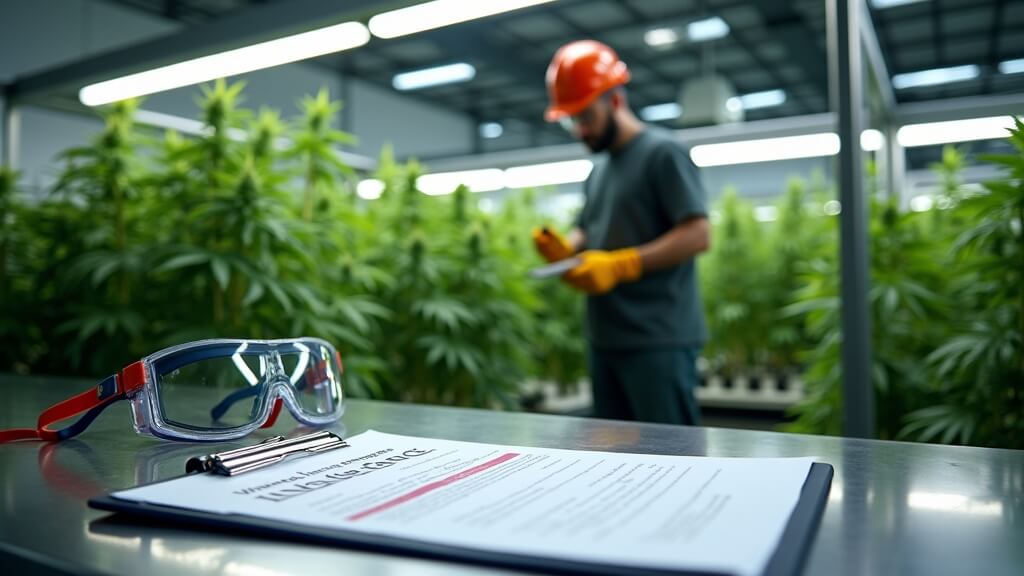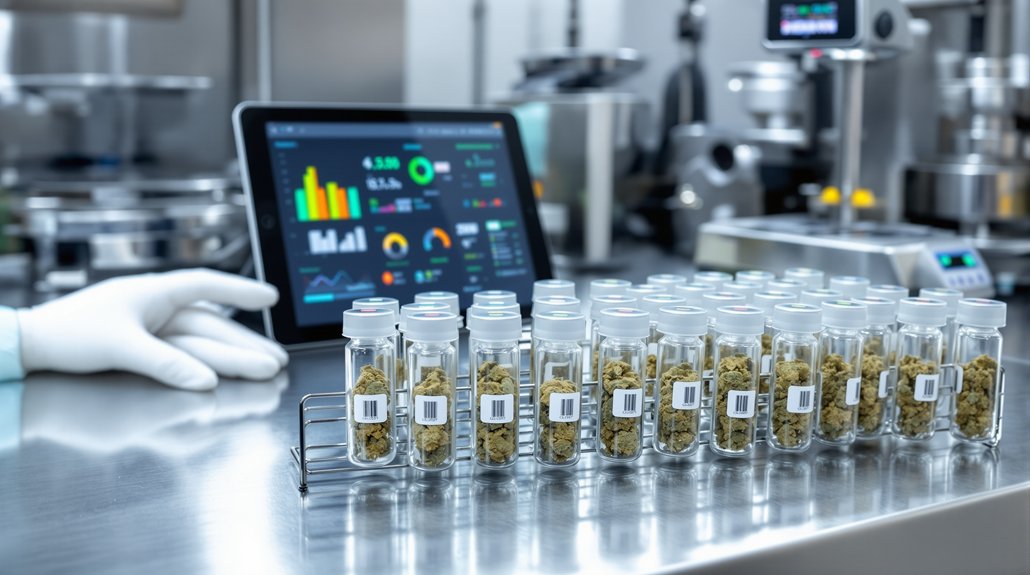The U.S. cannabis cultivation sector is evolving rapidly, with growers embracing high-tech innovations to boost quality and efficiency. Modern cultivators are investing in advanced genetics (breeding strains with higher terpene content, pest resistance, and optimized cannabinoid profiles) and precision agriculture. Techniques like automated climate control, AI-driven nutrient delivery, and energy-efficient LED lighting are becoming mainstream to improve yields and sustainability. The industry is scaling up with large greenhouse facilities employing performance-based teams and rigorous quality control to maximize output and consistency.
Despite surging demand (U.S. sales are projected to approach $45-$50 billion in 2025), cultivators face headwinds. Wholesale cannabis prices have dropped ~10% amid oversupply, squeezing margins even as operational costs rise. Regulations are becoming increasingly complex, demonstrating how important it is for businesses in the cannabis industry to have the necessary insurance coverage protecting their investment. This guide explores things to consider and potential pitfalls of the lack of adequate insurance.
In 2025, cannabis cultivation sits at a crossroads of great promise and significant risk. Embracing innovation and robust risk management, especially through tailored insurance will be crucial for cultivators looking to safeguard their growth in a volatile landscape.
Cannabis General Liability Insurance
Cannabis General Liability (CGL) insurance covers a business for third-party claims of bodily injury, property damage, or personal injury (libel, slander, etc.) that occur in the course of operations. In a dispensary or grow facility, this would address incidents like a customer slipping on a wet floor or a visitor getting hurt by equipment. However, standard general liability policies have critical gaps for cannabis businesses. Many traditional insurers still include cannabis or cannabinoid exclusions, meaning even basic liability claims could be denied if they relate to cannabis activity. As a result, cannabis companies often must turn to surplus-line carriers and pay higher premiums for CGL coverage, only to find that certain risks common to the industry are excluded.
Coverage Gaps vs. Traditional Businesses
Unlike mainstream businesses, cannabis operators cannot assume a CGL policy will cover all normal liability exposures. Policy exclusions are common. For example, some insurers add a “Controlled Substance” or “Public Policy” exclusion that voids coverage for any claim involving an illegal substance (despite state legality). Others explicitly carve out the “products-completed operations” hazard, meaning any injuries or damages caused by the cannabis products themselves are not covered. A standard business might have product liability included in their GL – but cannabis companies often find it excluded by default. These gaps leave firms vulnerable to lawsuits they thought were insured. Indeed, many operators only discover they are underinsured when a claim is denied, as happened to cannabis businesses that purchased generic policies not tailored to cannabis. It’s common for landlords or vendors to require proof of general liability insurance, but cannabis entrepreneurs must scrutinize those policies for exclusions that could render them useless when needed.
Carrier limitations also play a role. Until recently, most major insurance carriers refused cannabis accounts due to federal legality issues. Coverage has been available primarily through smaller specialty insurers in the excess & surplus market. These policies tend to have lower limits, higher deductibles, and cost significantly more than analogous coverage in other industries. For instance, one industry survey noted cannabis companies paying “steep premiums for limited protection” or resorting to self-insurance in the face of few options. While the landscape is improving as more insurers cautiously enter the space, companies still report difficulty securing affordable, adequate CGL insurance with about 75% saying they lack coverage that would truly protect profits in a serious claim. This capacity crunch drives costs up: in 2025, general liability and other premiums have spiked 25-40%, partly because some insurers and reinsurers pulled out of the market in 2024. Fewer carriers means cannabis businesses must often piece together multiple policies to fill all gaps, usually with help from a specialized broker.
Product Liability for Cultivators and Manufacturers
One of the most significant exclusions in many cannabis CGL policies is for product liability. This refers to claims arising from the products a company sells, for example a consumer lawsuit alleging they were sickened by a contaminated vape cartridge or mislabeled edible. In most industries, such claims would fall under the general liability’s products-completed operations coverage. But in cannabis, insurers routinely exclude product-related claims from GL policies. According to one analysis, standard policies often add “health hazard” or “impairment” exclusions, meaning any injury caused by ingesting or using a cannabis product (especially one that alters mental state) is not covered. Hardware like vape batteries can be excluded as well. In effect, a cultivator or manufacturer must secure a separate Product Liability Insurance policy to be protected if their product harms someone.
For cultivators, product liability risk includes scenarios like a medical patient suing over a pesticide residue in flower, or a recreational user claiming a gummy’s THC content was misrepresented. These lawsuits are on the rise and can be very costly, with settlements often exceeding $1 million. Notably, the cannabis industry has seen payouts for vape-related lung illness claims and edible potency mistakes in recent years. Without dedicated coverage, a company facing such a suit would have to pay all defense and settlement costs out-of-pocket.
Businesses that don’t realize this could be in for a rude surprise, since many landlords and state licenses require general liability, but nothing explicitly forces a purchase of product liability coverage. Experts warn that dispensaries often underestimate their exposure, assuming if they didn’t manufacture the product, they won’t be sued, which is a mistake: If a consumer has a bad reaction, most lawyers will name everyone involved, including the retailer. Thus, both cultivators and retailers should carry product liability insurance (or a GL policy endorsement adding it back) to truly cover claims arising from their goods.
Premises Liability for Retail Operations
For cannabis dispensaries and other customer-facing facilities, premises liability is a core component of general liability insurance. This covers injuries or property damage occurring on-site. In a retail store, common examples are slip-and-fall accidents, customer altercations, or display cases accidentally hurting a patron. Cannabis retailers actually face heightened premises liability concerns: high foot traffic, potentially long queues, and sometimes on-site consumption (in jurisdictions that allow lounges) all increase the odds of an incident. CGL insurance will defend the business and pay damages if, say, a customer trips over a loose cable in a dispensary or claims they were assaulted due to negligent security. These incidents are not unique to cannabis, but the cost factors may be higher. Many dispensaries have had to implement “extensive security and inventory-tracking systems to meet insurance requirements”, as one New York operator found when seeking coverage. Armed security guards, ID checks, and video surveillance are helpful for safety but also a tacit recognition of liability risk (and these measures may be mandated by insurers to even qualify for a policy).
Another consideration is cannabis consumption liability. If a business allows on-premises consumption (e.g. a tasting room or cannabis lounge), standard GL will not cover any injuries related to that activity unless specifically endorsed. This is akin to a bar needing liquor liability insurance. A few insurers offer cannabis impairment liability coverage for lounges or events, but many retailers mistakenly assume their GL is enough. It isn’t – without a special rider, any incident traced to on-site use of THC products would usually fall under an exclusion (often the impairment or intoxication exclusion). Given the emergence of cannabis cafes, it’s crucial such operators get the proper liability extensions.
Cannabis general liability insurance provides foundational protection (covering many routine accidents at a grow or store) and is often legally required to operate. But it comes with atypical coverage gaps, especially regarding product-related harm that must be filled by additional policies. Cultivators and dispensaries should work closely with knowledgeable brokers to close these gaps. Paying for separate product liability, consumption liability, or umbrella policies is often necessary to approximate the coverage a non-cannabis business gets in one package. Failing to do so means a false sense of security: a business might only discover after a lawsuit that their “coverage” excludes the very claim at hand. As industry attorneys emphasize, good insurance coverage is worth the effort in an environment where one lawsuit can be financially ruinous, comprehensive liability protection is even more critical for cannabis companies than for other industries.
Cost Factors and Carrier Limitations
The cost of CGL insurance for cannabis businesses tends to run significantly higher than for comparable mainstream businesses, reflecting the perceived higher risk and limited pool of insurers. Because cannabis remains federally illegal, many standard-market carriers stay on the sidelines, leaving a smaller number of specialty insurers to cover the entire industry. This dynamic results in high premiums, strict underwriting, and sometimes difficulty even obtaining a quote. In late 2024 and 2025, the crunch intensified: at least four regional insurance programs withdrew from the cannabis sector, pulling roughly $100 million in coverage capacity out of the market. The remaining insurers began cherry-picking the safest accounts, raising deductibles and requiring more stringent conditions. For example, underwriters now commonly mandate robust risk controls (e.g. burglar alarms, sprinkler systems, lab testing protocols) before offering general liability or property policies. A business with any red flags such as a previous claim, inadequate security, or operating in a high-crime area may find coverage only at exorbitant rates or not at all.
The bottom line is that cannabis liability insurance is costly and complex, but it’s a non-negotiable for serious operators. Companies should budget for higher insurance expenses (some have seen a 40% spike in premiums in 2025 alone) and plan early for renewals. Risk advisors recommend starting the renewal process 90+ days in advance and proactively improving your risk profile, e.g. documenting safety training, installing better security cameras to negotiate better terms. Over time, market conditions may ease as more insurers enter, there is optimism with new carriers and reinsurance support slowly growing, which could put downward pressure on premiums. But until then, cannabis businesses must navigate a tight insurance market by presenting themselves as best-in-class risks and working with brokers who know how to access the few willing insurers.

Product Liability Insurance
While General Liability Insurance covers everyday accidents, it almost always excludes claims tied to the products themselves. That leaves a critical gap for cannabis operators, because product liability is where the highest-dollar risks lie. Whether you are a cultivator, processor, or retailer, a single lawsuit tied to a defective, mislabeled, or contaminated product can easily reach six or seven figures. Product Liability Insurance exists to fill that gap, protecting businesses from claims of bodily injury or property damage caused by the cannabis products they grow, manufacture, or sell.
Why Product Liability Is a Must-Have
Cannabis businesses operate in a consumer product space similar to food, beverages, or pharmaceuticals, all industries where product liability insurance is standard. Courts and regulators increasingly apply strict liability standards, if your product injures someone, you can be held responsible even without negligence. In cannabis, common scenarios include:
Contamination Claims: Moldy flower, pesticide residues, or heavy metals in vape oil. Even with state-mandated testing, errors or post-lab contamination can occur.
Potency and Labeling Errors: A mislabeled edible with higher-than-listed THC can lead to overdoses or hospital visits. Class action lawsuits have already been filed against brands for inaccurate potency labels.
Defective Hardware: Exploding vape batteries or leaky cartridges are product liability events. Even if the hardware was sourced from a third-party supplier, retailers and brands can still be named in lawsuits.
Allergic or Adverse Reactions: Customers alleging harm from ingredients (e.g., peanut oil, terpenes, or cutting agents) may pursue claims.
The financial stakes are high: cannabis product liability settlements have averaged over $1 million per case in recent years. Without insurance, defense and settlement costs would be borne entirely by the business, which is a potentially existential threat for smaller operators.
Who Needs Coverage the Most
Product liability coverage is relevant across the entire cannabis supply chain, but some operators are more exposed than others. Cultivators face significant risk if contaminated flower reaches the market or if pesticide residues are discovered after sale, even when products initially passed lab testing. Manufacturers and processors carry the highest liability, since they are responsible for formulating edibles, concentrates, and infused products where a single misstep in labeling or production can lead to consumer illness or regulatory action. Retailers and dispensaries are not exempt, either. Even if they had no hand in cultivation or manufacturing, they are often pulled into lawsuits simply because they sold the product to the end consumer. In practice, the legal principle of strict liability means that everyone in the chain of distribution, from grower to retailer, can be held responsible if a product causes harm. For this reason, any business that touches the plant or sells cannabis products directly should consider product liability coverage essential, not optional.
What Product Liability Policies Typically Cover
Product Liability Policies are designed to step in when a business faces claims that its products have caused harm. At its core, this type of coverage pays for bodily injury or property damage linked to cannabis products, ensuring that a single contaminated batch or mislabeled edible doesn’t put the entire business at risk. It also provides for legal defense costs, which can escalate into the hundreds of thousands of dollars even in cases that are ultimately dismissed. If a claim results in a settlement or court judgment, the policy covers those financial awards as well.
Many insurers also offer recall expense coverage, an increasingly important feature in a heavily regulated industry. This reimburses the costs of pulling defective or unsafe products from shelves, covering everything from public notifications and shipping to safe disposal. Considering how quickly recalls can erode brand trust and drain cash reserves, this safeguard can be the difference between recovery and closure.
Because General Liability policies almost always exclude these risks, product liability coverage is typically purchased as a standalone policy or added by endorsement. For cannabis operators, it’s a critical layer of protection that allows the business to weather the unpredictable challenges of selling a federally restricted consumer product.

Property Insurance for Cannabis Operations
Property insurance protects a cannabis company’s tangible assets like buildings, indoor grow facilities, greenhouse structures, equipment, finished inventory, and other business property against losses from perils like fire, theft, vandalism, and certain natural disasters. In many ways it functions like standard commercial property coverage: if a covered event (e.g. a fire) damages your cultivation facility or destroys your stock, the policy pays to repair the building and compensate for the lost crop/inventory value (subject to limits). However, cannabis property insurance also has unique considerations and challenges. High-value cannabis inventory and live plants, specialized growing equipment, and the risk of crop contamination or seizure are issues not encountered in typical industries. Additionally, some common perils in agriculture, such as mold or pests may not be covered without special endorsements. Much like liability insurance, standard property policies often exclude key cannabis-related exposures, necessitating customized solutions.
Crop Insurance Challenges and Alternatives
One glaring gap is that growing crops are usually excluded from standard property coverage. For ordinary farms, crop insurance is often provided through federal programs or specialized farm insurers, but because cannabis (with THC) is federally illegal, cultivators cannot purchase federal crop insurance for their plants. Traditional commercial property policies explicitly do not cover live plants or harvested product in many cases, treating them as contraband or simply outside the scope. As a result, cannabis growers must seek specialty crop insurance (sometimes called Finished Stock or Living Plant coverage) through niche insurers. These policies can cover the value of plants at various stages: from seedlings and vegetative plants up to harvested buds waiting to be sold. They protect against perils like greenhouses catching fire, irrigation failures, equipment breakdowns that kill plants, theft of plants, and even certain weather events if outdoors.
Securing crop insurance isn’t straightforward. Underwriters worry about losses from mold, disease, or outdoor events (e.g. wildfires, hurricanes) that could wipe out entire grows. Premiums are correspondingly high, and claims can be contentious, meaning the burden is on the cultivator to prove a covered peril caused the loss, not just grower error or negligence. Furthermore, some perils remain uninsurable or very costly to insure. For example, federal raids or law enforcement confiscation of plants cannot be insured (they fall under illegal acts). Also, many policies exclude damage from pathogens or cannabis-specific diseases unless added via endorsement.
Cultivators have to carefully review policy language to understand what triggers a payout. There have been cases where growers thought their crop was covered, only to find that a mold outbreak was excluded as a “contamination” not caused by an external peril. Parametric insurance solutions are emerging as one alternative: these pay a set amount if a defined event occurs (like rainfall below a threshold or a wildfire in the area), without investigating the actual crop damage cause, thus sidestepping some disputes. A few states have also explored creating cannabis-specific risk pools or captives to offer crop coverage. For instance, New York and Nevada regulators in 2025 were evaluating state-backed cannabis insurance captives that might launch soon. These could provide some relief by insuring risks that private carriers shy away from, such as crop losses from certain natural disasters.
For now, every cultivator should assume their living plants are NOT covered by a generic property policy and seek proper crop coverage. As a legal advisory firm noted, “Cultivating cannabis is a high-stakes endeavor, susceptible to loss from weather events, disease, mold, and even theft. Specialized crop insurance policies help mitigate the financial impact of losing a harvest.” Without it, a bad storm or infestation could result in a total loss of a grow worth millions, with no compensation, a business-ending scenario for many. Notably, even post-harvest “inventory” coverage must be verified: some insurers will cover processed, packaged cannabis stock (finished goods), but not the plants in the ground or drying stage. Hence cultivators often carry a patchwork: one policy for structures/equipment, another rider for harvested stock, and yet another for living plants. This can be pricey but is crucial risk management given the impossibility of replacing a lost crop revenue quickly in a licensed market.
Equipment and Facility Coverage
Cannabis facilities range from indoor warehouses packed with high-intensity lights and HVAC systems to hybrid greenhouses and outdoor farms. Protecting the physical facility and equipment is vital, as they represent huge capital investments. Property insurance generally covers the building structure itself and business personal property (equipment, furniture, etc.) against standard perils (fire, theft, wind, etc.). But again, cannabis operators must watch for exclusions. Leading cannabis insurers will pay legitimate claims, but it underscores why using cannabis-specific insurers is important. You want a carrier that explicitly knows it’s covering a cannabis operation.
Specialized equipment like grow lights, hydroponic systems, extraction machines, and specialized HVAC units can be covered, but it’s important to list these assets with accurate values. One challenge is equipment breakdown coverage: standard property policies typically do not cover mechanical breakdown or electrical burnout by default. If a power surge fries your lighting control system or an air conditioner compressor fails (not due to an external covered event), the repairs and crop losses due to overheating would normally not be covered. Cannabis businesses should consider adding Equipment Breakdown Insurance (akin to boiler & machinery coverage) to fill this gap. This endorsement would pay to repair or replace critical systems that suffer internal failures and even cover resultant losses (some policies might cover the crop damage resulting from an HVAC failure under such an endorsement, whereas standard property would not).
Facility security requirements tie in here: insurers often make coverage contingent on having appropriate alarms, camera surveillance, safe/vault for product, and sometimes even armed guards for certain high-value sites. If a theft occurs and the facility’s security was substandard, an insurer could deny the claim for lack of due care. Indeed, carriers now expect “UL-rated electrical work, fire suppression systems, and pest-control documentation” before they will even underwrite property coverage for an indoor grow.
These risk mitigation measures are essentially becoming prerequisites. The investment pays off: modern fire suppression and security can not only reduce premiums but also prevent catastrophic losses. A spate of indoor cultivation facility fires in 2023 (many caused by faulty wiring of high-wattage equipment) led insurers to drastically tighten underwriting and require proof of professional electrical inspections. Growers should be prepared to demonstrate compliance with all such safety standards when applying for or renewing coverage. Skipping on these upgrades can make insurance unobtainable or astronomically priced.
Business Interruption Insurance
Business Interruption (BI) coverage, usually offered as an add-on to property insurance, is especially important for cannabis operations that cannot easily replace lost income after a disaster. BI insurance reimburses the lost profits and continuing expenses if your business is shut down due to a covered property loss. For example, if a fire damages your cultivation site and halts production for 3 months, BI coverage can pay for lost revenue in that period (based on projections) and help cover ongoing costs like leases or loan payments. Considering how long it takes to regrow a cannabis crop, BI is crucial, a cultivator might lose not just the current harvest to a fire, but also months of future harvest cycles while rebuilding.
However, cannabis businesses often struggle with BI claims because of compliance issues. Insurers may exclude BI losses if the delay is caused by regulatory hurdles rather than physical damage alone. For instance, rebuilding a facility might be quick, but re-licensing or passing inspections could delay reopening and some policies won’t cover that extra delay unless specifically addressed. Moreover, if the triggering event isn’t covered (e.g. a wildfire is covered, but what about smoke taint that ruins crops without burning the building? Some policies might not cover smoke contamination to crops), then BI won’t pay either. Cannabis firms should negotiate for as broad coverage as possible, including “contingent business interruption” if a key supplier or partner’s incident (say your sole extraction lab partner burns down) affects your revenue. They should also consider extra expense coverage to cover the cost of mitigating losses (like renting a temporary facility).
Security System Requirements and Impact on Coverage
Cannabis operations are subject to stringent, legal security requirements and insurers likewise insist on strong security protocols to reduce theft and vandalism claims. This industry deals in a high-value, easily resold commodity and often holds large amounts of cash due to banking restrictions. Thus, insurers evaluate physical and cyber security measures closely when underwriting property and liability policies. As mentioned, property underwriters often require measures such as: 24/7 video surveillance with long retention periods, biometric or badge-controlled access for facilities, reinforced vaults or safes for stored product, and GPS-tracked vehicles for transport. A 2024 industry report noted that underwriters are expecting modern security tech and inventory controls like seed-to-sale tracking with <1% daily inventory variance.
From an insurance perspective, better security directly translates to fewer claims (or at least mitigating losses when incidents occur). For example, a dispensary burglary that might have cost $200k in losses could be limited to $20k if a vault secures most product and alarms trigger quick police response. Recognizing this, some insurers offer premium credits for exceeding baseline security. Conversely, if a business fails to maintain required security, claims can be denied. It’s not uncommon for policies to include warranties or conditions: e.g. an alarm system must be armed whenever premises are closed, a guard must be on duty during certain hours, etc. A breach of these conditions (say the alarm was off at the time of a break-in) could allow the insurer to decline payment. Therefore, cannabis companies must not only invest in robust security, but also diligently use and maintain those systems as per policy terms.
Insurance aside, strong security is mandated by state regulations (cameras, limited access areas, etc.), so most legal operators already have significant measures in place. But insurers may require documentation and even inspections. Enhanced measures like third-party security audits, redundant alarm communications (cellular backup), and integration of seed-to-sale software with alarm triggers can further reassure insurers.
Property insurance for cannabis covers the critical assets of the business but must be approached with an understanding of its limits. Gaps like crop coverage and equipment breakdown need special solutions. Meticulous attention to security and risk management is rewarded by insurers, often it’s the only way to obtain coverage at all. And because even the best precautions cannot prevent all disasters, having proper property and business interruption insurance is a lifeline. As one state regulator put it: “Make sure your insurance company understands the nature of your business… your standard insurance company may refuse to sell you a policy because of [cannabis]. However, there are surplus lines companies that will”. The goal is to avoid any surprises in coverage.

Professional Liability & Errors and Omissions
Not all cannabis businesses are plant-touching. Many provide professional services, from laboratory testing and quality assurance to regulatory consulting, legal advice, technology platforms, and beyond. Professional Liability Insurance, also known as Errors & Omissions (E&O) insurance, protects these service providers from claims that their negligence, errors, or omissions in performing professional duties caused a client financial harm. In the cannabis industry, this coverage is increasingly essential. As the sector matures, companies are relying on external experts for critical functions (ensuring compliance, formulating products, auditing security, etc.), and if those experts make a mistake, the fallout can be costly. E&O insurance will cover legal defense costs, court judgments, or settlements arising from such claims, up to policy limits.
Who needs E&O in cannabis? Compliance consultants (advising on licensing and regulatory adherence), cultivation and processing consultants (advising on grow techniques or extraction methods), testing laboratories (providing certified analysis of potency and purity), product formulation specialists, marketing agencies, software providers (seed-to-sale tracking systems), and even venture capital or investment advisors specializing in cannabis. All these roles carry professional risk. If their work is subpar or mistaken, clients might sue for damages.
Notably, cannabis testing labs have a high E&O exposure: a lab error in measuring THC or contaminants could lead a producer to release a mislabelled or unsafe product, triggering recalls and lawsuits, and the producer will in turn hold the lab responsible. One insurance guide points out that “a procedural error during testing or equipment malfunction could lead [a lab] to give incorrect results… consumer safety, your customer’s reputation (and yours), and legal liability could be on the line. Professional liability policies can help defend your business if a claim like this arises.” For example, if a lab’s negligence allowed a batch of pesticide-laden cannabis to be falsely certified as clean, the lab could face claims from both the producer and harmed consumers. Without E&O insurance, the lab would shoulder all defense and payout costs alone, which could be ruinous for a small analytical company.
Compliance Consulting Liability
Compliance consultants guide businesses through complex licensing and regulatory requirements such as preparing state license applications, crafting standard operating procedures to meet state rules, or conducting compliance audits. If they make a mistake, the financial consequences for clients are huge: a missed filing deadline or a bad piece of advice could lead to license denials, fines, or even forced business closure. In such cases, the client may sue the consultant for damages. For instance, suppose a consultant advised a dispensary that a certain marketing practice was allowed, but it actually violated regulations and resulted in a $50,000 fine and a 2-week license suspension. The dispensary could pursue the consultant for those losses, alleging professional negligence.
Professional liability insurance would step in to defend the consultant and cover the claim if warranted. Importantly, some E&O policies for cannabis consultants include coverage for regulatory defense, meaning if a consultant themselves is named in a state investigation or accused of facilitating non-compliance, the policy can cover legal defense costs. Coverage of government penalties varies and may require specific endorsements. Many policies exclude intentional violations and regulatory penalties by default, so consultants should seek policies that at least cover defense costs for unintentional compliance errors.)
Given the patchwork of state laws and constant rule changes, compliance advisors are at high risk of an oversight. They are essentially insuring their expertise, acknowledging that even an expert can slip up in this fast-evolving field. And as cannabis firms become less tolerant of costly mistakes, they will likely demand that their consultants carry E&O (just as hospitals require their vendors to carry malpractice or E&O insurance).
Testing Lab E&O Coverage
Cannabis testing laboratories provide certified analyses of products for potency (THC/CBD levels) and safety (pesticides, microbes, heavy metals, etc.). They are often the final quality gatekeeper before a product goes to market. A lab’s professional service is the accurate testing and reporting of results. If they make mistakes such as contaminant levels reported incorrectly, or potency miscalculated, it can have serious repercussions. For example, a false negative on a contaminant could mean tainted products reach consumers, leading to health issues and recalls. A big discrepancy in potency results could mean a product is mislabeled (violating regulations and misleading consumers). In these scenarios, product manufacturers or even consumers could sue the lab for negligence.
Professional liability insurance is crucial for labs to cover such claims. It will pay for attorneys, expert witnesses, and any settlements/judgments if the lab is found liable for errors in their testing process. A real-world scenario: In California, a cannabis lab was sued by a cultivator after the lab’s mistake caused the cultivator’s product to be flagged for high pesticide levels that were actually a testing error – the cultivator lost a lucrative sale and damaged its reputation. E&O insurance would cover the lab’s cost to defend itself and any payout if they’re at fault.
The risk factors for labs include human error (technician mistakes), equipment calibration issues, software bugs in laboratory information systems, or even sample contamination. With tight state mandates on lab accreditation, any slip can become both a compliance violation and a civil liability issue. It emphasizes that labs must have the right insurance and risk management to safeguard their business, acknowledging that having the right insurance can help keep your assets safe and mitigate potential liabilities when errors happen.
Professional Service Provider Risks
Beyond compliance and labs, any professional service provider in cannabis faces E&O exposures. This includes:
Lawyers and Accountants: Even though these professionals typically carry their own malpractice insurance, those serving cannabis clients have unique risks (e.g. advising on tax strategy under 280E, or legal interpretations of evolving regs). A minor mistake in a cannabis business’s tax filing by an accountant could lead to an IRS penalty, for which the client may blame the accountant. Traditional professional liability covers many of these, but some insurers add exclusions for cannabis work, so cannabis-focused firms often need specialty coverage as well.
Product formulators and R&D consultants: If a chemist or food scientist advises a company on a new edible formulation and that product fails or causes consumer complaints, the company might claim the consultant’s guidance was faulty.
Security consultants: They might design a facility’s security plan. If a major theft occurs and it’s alleged the plan was inadequate, they could be liable for the lapse.
Software/Tech providers: For example, a seed-to-sale tracking software company or a dispensary point-of-sale provider. If their system crashes or produces errors that cause compliance breaches (like incorrect tracking of inventory leading to state penalties), clients could seek damages. Tech E&O (a subset of professional liability) would apply here to cover failures of software or systems that cause financial loss.
Marketing and branding agencies: If an agency’s campaign unintentionally violates advertising restrictions (e.g. targeting minors or making false claims), resulting in fines or a license ding for the client, the client could pursue a claim with the agency.
One unique aspect in cannabis is the interplay with regulation. Many professional mistakes in this field simultaneously trigger regulatory problems. For instance, a labeling consultant’s error could both lead to consumer lawsuits and a state product recall order. Thus, the E&O policy ideally should cover regulatory defense and licensing board actions in addition to civil suits. Some insurers offer sublimits that pay for legal representation in front of a state cannabis commission or health department if a licensed professional (like a lab director or a consultant) is facing sanctions. Without that, even if the fine itself isn’t insured, the legal fees (which can be immense) would be out-of-pocket.
Claims Examples and Risk Prevention
Preventive measures for professionals include strong quality controls, clear client contracts, and staying within areas of expertise. Documenting all advice and decisions can help defend against unfounded claims. Many E&O policies require that the insured not admit fault and notify the insurer promptly if an incident occurs that could lead to a claim. Training and credentialing also matter: a firm is less likely to be negligent if staff are well-trained and following standard protocols. In labs, for instance, ISO accreditation and round-robin testing can catch errors before results go out.
From a risk management view, one key is managing client expectations via contract. Use engagement letters that limit liability where possible, include dispute resolution, and clarify the scope of services. While such clauses aren’t foolproof, they can deter lawsuits or cap damages. Also, maintain good communication – often, clients sue because they feel misled or abandoned when something goes wrong. If you proactively inform clients of issues and help mitigate them, it may never escalate to a claim.
Professional Liability/E&O insurance acts as malpractice coverage for the cannabis industry’s brains and advisors. As cannabis businesses increasingly rely on third-party expertise, they will hold those experts accountable for mistakes. Having E&O not only provides financial protection but can be a selling point, showing clients you stand behind your work. The coverage ensures that a single oversight doesn’t bankrupt a consultancy or lab. Instead, the insurer bears the brunt of legal costs and any settlement, so the professional can continue operating. Given the still-evolving nature of cannabis regulations (and the likelihood of misunderstanding or missteps), E&O insurance is quickly moving from optional to essential for ancillary cannabis businesses. It’s part of building a resilient, trustworthy service sector around the plant-touching core.

Workers’ Compensation in Cannabis
Workers’ Compensation insurance provides no-fault coverage for employees who suffer work-related injuries or illnesses, covering their medical treatment and a portion of lost wages, while generally barring them from suing the employer for those injuries. It is legally required for virtually all businesses with employees in the U.S., and cannabis companies are no exception. However, cannabis operators face unique challenges in securing and managing workers’ comp coverage. They also contend with distinctive workplace hazards from the farm, to the extraction lab, to the retail dispensary that require tailored safety strategies.
State requirements: Workers’ comp is mandated at the state level, and each state has its own rules. In states where cannabis is legal, regulators typically require licensed operators to show proof of workers’ comp insurance as a condition of obtaining or renewing a license. For example, California explicitly extended its workers’ comp laws to cover cannabis businesses, and the state-run insurer (State Fund) offers policies to cannabis employers. Some states, however, have presented hurdles. Not all private insurers are willing to cover cannabis firms (especially in jurisdictions where the industry is new). While employers must have coverage, insurers are not obligated to sell it. If a cannabis company can’t find a willing carrier, they often must turn to an assigned-risk pool at higher rates. Notably, federal illegality does not exempt an employer from state comp laws even though cannabis is illegal federally, state-recognized cannabis businesses must comply with state workers’ comp mandates like any other employer.
Unique occupational risks: Cannabis cultivation, processing, and retail involve a mix of agricultural, manufacturing, and customer-service environments, each with their own dangers. A 2024 industry safety briefing highlighted some sector-specific hazards:
Cultivation site risks: Workers may face exposure to pesticides and fertilizers (chemical hazards), heavy lifting and repetitive motions (ergonomic strain from tasks like trimming or potting plants), use of machinery (such as extraction equipment or trimming machines that can cause injuries), electrical hazards from extensive lighting setups, and even respiratory issues from prolonged exposure to organic dust or mold spores in grow rooms.
Manufacturing/Extraction risks: If the operation includes extracting oils or producing concentrates, workers could encounter flammable solvents (butane, ethanol) posing risks of fires or explosions. There’s also the typical industrial machinery risks (presses, ovens, etc.), plus chemical exposure if handling solvents or CO2. Several extraction facility accidents in the past have demonstrated these dangers.
Retail and Distribution risks: Dispensary staff face security risks, armed robberies have occurred at dispensaries given the cash on hand, putting employees at risk of assault or PTSD after violent incidents. Delivery drivers face the same road risks as any commercial driver (accidents) and the added target of carrying cash/products. Repetitive stress can occur for budtenders constantly packaging product or handling POS systems, and general slips, trips, and falls in a busy store are possible.
State-Specific Challenges and Solutions
Some states have had issues with cannabis and workers’ comp. For instance, in the early days, Washington and Colorado found that some comp carriers were hesitant, but over time those states integrated cannabis into normal comp markets. In North Dakota and Ohio (states with monopolistic state funds for comp), initially there were questions about whether those state funds would cover cannabis businesses, most have resolved to do so as long as the business is state-legal. One related issue is medical marijuana in workers’ comp: if an injured worker in a state has a medical cannabis card, can they get their cannabis paid for as a treatment under comp? Some states explicitly exclude that (e.g. Florida, North Dakota disallow reimbursement for medical cannabis in comp claims). However, that’s more about injured workers using cannabis than about cannabis companies as employers.
From the employer perspective, the main challenge is cost and safety. Because of the risks mentioned and perhaps stigma, cannabis businesses might face higher workers’ comp premiums than a similarly sized business in another industry. Data is still emerging, but anecdotal reports suggest premiums are elevated until an individual company establishes a safe track record. Another challenge: many cannabis businesses are relatively new and may not have robust HR and safety programs, which insurers consider when pricing comp. Also, if an employee is injured and tests positive for cannabis (even from legal off-duty use), some states allow denial of the claim on grounds of intoxication. This can be legally thorny in a cannabis-legal state. Employers should understand their state’s rules on post-accident drug testing and intoxication defenses.
To navigate these challenges, cannabis companies can work with insurance brokers who specialize in the industry to find carriers or programs that will take them. Some larger cannabis firms consider captives for workers’ comp if they are big enough to self-insure partially. On the regulatory side, engaging with state cannabis boards and lawmakers can help ensure cannabis businesses are integrated into state insurance frameworks (for example, advocating that state comp funds open coverage to them if private markets fail).
Safety Training Requirements
A proactive safety culture is the best way to reduce workers’ comp costs. Safety training is not only common sense but often a regulatory expectation. Many states require cannabis licensees to have an employee safety plan, and OSHA standards apply to cannabis facilities as they would to any workplace. Key training topics include:
Proper handling of chemicals: Employees should be trained and, where required, certified in safe use of pesticides (often under state agriculture rules) and extraction solvents. This includes using personal protective equipment (PPE) like gloves, masks, and eye protection, and knowing emergency procedures (like what to do if there’s a butane leak).
Ergonomics and repetitive motion: Trimmers, packagers, and budtenders performing repetitive tasks should be trained in stretches, proper posture, and task rotation to prevent injuries like carpal tunnel or back strain. Some companies bring in ergonomics specialists to adjust workstations like providing scissors with better grips or anti-fatigue mats for those standing all day.
Equipment and machinery operation: Forklift training for warehouse workers, safe operation training for extraction machines, proper lockout/tagout procedures on electrical equipment, all these general industry trainings need to be implemented.
Security and robbery response: Especially for dispensary staff and delivery drivers. Training on how to de-escalate robberies (comply with demands, avoid heroics) can save lives. Unfortunately, robberies have led to injuries and even deaths, making this a real concern.
Some states might have additional requirements. For instance, Cal/OSHA in California has issued industry-specific guidance for cannabis businesses, reinforcing general injury and illness prevention program (IIPP) requirements. Meeting such guidelines isn’t just about compliance, it demonstrates to insurers that the company is serious about safety.
Claims Management Best Practices
Even with the best prevention, injuries may occur. How an employer handles those injuries can dramatically affect claim outcomes and costs. Best practices for claims management in cannabis are similar to other industries:
Report injuries promptly: Don’t delay in filing the claim with the insurance carrier. Prompt reporting can get the employee quicker medical care (improving outcomes) and can reduce the chance of litigation. It also helps investigate while details are fresh.
Maintain communication with injured employees: Let the employee know they are valued and you want them healthy and back to work. Fear or confusion can drive workers to hire attorneys; maintaining a supportive dialogue can prevent adversarial situations.
Offer modified duty / return-to-work programs: If possible, provide light-duty jobs to bring injured employees back to work as soon as medically feasible. For example, if a trimmer has a hand injury, perhaps they can do administrative filing work temporarily. This keeps them engaged and reduces indemnity payments (wage loss), which lowers claim cost. In cannabis, creative modified duties might include inventory counting, cleaning tasks, or patient greeter roles.
Work closely with adjusters and medical providers: Cannabis employers should ensure the insurance adjuster understands any nuances of the job when coordinating care. If there are only certain doctors who truly know about, say, repetitive strain from trimming, suggest those clinics. Also, monitor the claim progress, don’t be passive.
Finally, because the cannabis industry is relatively new to formal workers’ comp, some employees might be unfamiliar with the process. Providing guidance to employees on how to report injuries and what to expect can improve cooperation and outcomes. Emphasize that comp is a no-fault system, they’ll get care and wage support regardless of fault, and it’s in everyone’s interest to focus on recovery.
Cost Control Strategies
Workers’ comp premiums are largely driven by two things: the employer’s payroll (size of workforce) and their loss history (claims costs over time, which determine their experience modification factor). Cannabis companies can’t easily avoid having employees or paying them, but they can control the frequency and severity of injuries to manage costs. Several strategies include:
Risk Identification and Analysis: Proactively identify where injuries might happen. Use incident data, even near misses to find trends. If trimmers are getting hand strains often, that’s a flag to change tools or schedules. If delivery drivers have frequent small vehicle accidents, invest in driver training and telematics. Larger firms are using data to target their biggest loss drivers.
Safety Incentive Programs: Some companies implement rewards for safety suggestions or for injury-free periods, to engage workers in prevention. Be cautious these programs don’t discourage reporting and focus on positive reinforcement.
Ergonomic improvements: A small investment in better tools or workstation setup can pay dividends in fewer strain injuries. For example, adjustable-height tables for bud trimming, or electric pruning shears for large grows, reduce physical stress.
Formalized Training and SOPs: Building an ongoing program (with refreshers, updates as laws change, etc.) is key. Also ensure standard operating procedures (SOPs) incorporate safety steps, e.g. an SOP for pesticide application that includes all required PPE and ventilation.
Partner with knowledgeable insurers or brokers: Many insurance carriers offer loss control services. A carrier specializing in cannabis might provide on-site safety consultations or materials specific to grow operations. They might help set up a claims review process. Don’t hesitate to use these resources; they can often lower premiums if you show improvement.
Consider higher deductibles or dividends: Some insurers might offer a deductible plan or pay-back dividends for low claim costs. If you have confidence in your safety program, these can save money (but require capital to absorb small losses).
Over time, a safe cannabis business can see its experience mod drop below 1.0 (which reduces premiums). On the flip side, a few severe injuries can send costs soaring. The stakes are high, a single serious injury could cost hundreds of thousands in medical and indemnity payments, affecting insurability. Thus, creating a culture of safety is often emphasized.
In conclusion, workers’ compensation in cannabis is both a challenge and an opportunity. It’s legally required and can be expensive, but it’s also a framework that, when managed well, protects workers and companies alike. A well-conceived comp policy ensures employees are cared for, which in turn safeguards the business from crippling liability. With the right risk management, safety training, fast claim resolution, and strong partner relationships, cannabis companies can keep their workforce healthy and their comp costs under control. By cultivating a safe work environment, cannabis entrepreneurs are not just complying with the law but investing in the longevity and efficiency of their operations.

Cyber Liability and Data Protection
In the digital age, cybersecurity and data protection have become critical concerns for cannabis businesses, perhaps even more so than in many other sectors. Cannabis companies routinely handle sensitive personal information (from medical marijuana patient records to customers’ IDs and purchase history), operate e-commerce and point-of-sale systems, and rely on state-mandated seed-to-sale tracking databases. Yet, historically, the industry’s focus has been on cultivation and compliance, meaning cyber risk has sometimes been overlooked. That is changing fast. Cyber liability insurance is now recognized as a key component of a cannabis firm’s risk management, covering costs associated with data breaches, hacking incidents, ransomware attacks, and other digital threats that could otherwise be devastating.
High Stakes of PII and PHI in Cannabis
One reason cannabis businesses are juicy targets for hackers is the troves of Personal Identifying Information (PII) and Protected Health Information (PHI) they maintain. Medical dispensaries, in particular, collect detailed health data: to issue a medical cannabis card or recommendation, patients may submit diagnoses, physician letters, IDs, and even Social Security numbers. Recreational retailers scan customer IDs, recording names, birthdates, and sometimes addresses or purchase habits. For context: a 2025 breach in Ohio exposed nearly 1 million medical cannabis patient records, including full names, SSNs, IDs, and health conditions, a treasure trove for identity thieves. Such highly sensitive data (e.g. proof of conditions like cancer or PTSD used in card applications) falling into the wrong hands can lead to identity theft, fraud, or public exposure of individuals’ private medical usage. The reputational damage to the company responsible can be irreparable, and legal consequences loom under privacy laws.
Even for adult-use customers, whose data might be “just” PII rather than health info, a breach is serious. Consumers trust dispensaries with copies of their driver’s licenses, and often those systems have purchase records that could embarrass or inconvenience customers if leaked (imagine a prominent individual’s cannabis purchases being dumped online). In some states, exposure of medical data could trigger HIPAA considerations or state health privacy laws, leading to regulatory fines on top of lawsuits. In fact, everyday operations can inadvertently violate privacy if not careful: “Patient data, often stored in POS systems, is often downloaded, emailed, and shared with numerous parties… Lots of things can bring a cannabis business to its knees; a HIPAA violation is right at the top of that list.” This highlights that many dispensaries and their partners might be playing fast and loose with patient data (sharing spreadsheets with personal info to vendors, etc.), creating liability even without an outside hack. It only takes one disgruntled employee or misconfigured database to leak that info.
Given these stakes, data protection requirements are tightening. Many states have laws requiring cannabis licensees to implement reasonable safeguards for personal data (some refer to their general data protection statutes, like California’s CCPA). Some medical-use states may treat dispensaries as akin to healthcare providers for data security expectations. At a minimum, regulators frown upon any public exposure of patient/customer info and can sanction a licensee for such lapses. Cyber insurance can’t stop regulators from fining you, but a good policy can cover the notification costs, credit monitoring for affected individuals, forensic investigation expenses, legal defense, and even some regulatory fines (depending on policy terms) following a breach.
Payment Processing Vulnerabilities
Because cannabis remains federally illegal, mainstream payment processing (credit/debit networks) has been restricted. This has forced the industry to adopt workarounds, and those workarounds come with their own vulnerabilities. For years, many dispensaries relied on “cashless ATMs”, essentially tricking the banking system by running a debit card as an ATM withdrawal to a fake location. This system moved billions of dollars but in late 2022 began to collapse when payment processors shut them down. The abrupt shutdown of cashless ATMs left many retailers scrambling, unable to accept cards and forced back to all-cash overnight. The risk here is not a data breach per se, but operational: dependence on shaky payment methods can grind sales to a halt if those methods are outlawed or cut off. It’s a reminder that cannabis finance is on thin ice until federal reforms allow normal banking.
Even current “more compliant” solutions (like PIN debit through certain fin-techs) rely on third-party tech that could fail or be targeted by hackers. Many dispensaries now use mobile apps or ACH-based payment systems. These can be hacked or abused, for example, an attacker might exploit an app vulnerability to siphon funds or steal customer banking info. The heavy use of cash due to banking issues means cyber criminals might target internal systems: e.g., a virus that skims data from point-of-sale systems to later empty accounts or clone cards. There’s also the risk of insider cyber theft, an employee could illicitly copy customer data or divert e-commerce payments, expecting that a cash-heavy business might not have robust IT controls to catch it.
Another angle: Cryptocurrency adoption. Some cannabis businesses have tried accepting crypto as a way around banks. This introduces different cyber risks (hacks of crypto wallets, phishing to steal private keys, etc.). If a dispensary’s crypto payment system got hacked, funds could be irretrievably stolen, and customer data linked to those transactions might be exposed.
Cannabis payment processing has many potential pitfalls: the lack of stable, federally-insured banking forces novel solutions that can fail spectacularly. While this is more of a business continuity issue, a cyber policy might help if, say, a technical failure or fraud in a payment system leads to losses. Importantly, many cyber insurance policies cover fund transfer fraud (social engineering) and theft of digital assets. So if an employee gets spoofed by a hacker impersonating a vendor and wires money out (a growing threat with AI-assisted phishing, cyber insurance could cover that loss. Cannabis firms, dealing with large cash management and unconventional transactions, are indeed targets for such scams. This advice is particularly pertinent to cannabis CFOs juggling multiple accounts and perhaps non-traditional banks.
Seed-to-Sale System Risks
Every licensed cannabis product is tracked from seed to final sale via mandated software systems (e.g. Metrc, BioTrack, MJ Freeway, etc.). These systems are critical infrastructure for the industry and have proven to be points of failure in the past. A famous incident occurred in Washington state (2018) when hackers breached the state’s traceability system (MJ Freeway’s platform). The attack downloaded a copy of the cannabis movement database and disrupted inventory transfers for several days. During that outage, producers and retailers couldn’t digitally manifest or receive shipments, essentially freezing a chunk of the market. The hack exposed manifest route information and vehicle details (though fortunately not personal consumer data) but that’s alarming on its own, as route data could be used by criminals to target transports. The issue forced the state to scramble with a “stopgap” system until the main one was secured.
This example underscores two risks: (1) a breach of the seed-to-sale system can expose sensitive business data (like crop locations, inventory volumes, transport schedules) which could be exploited by competitors or thieves; (2) an outage of the system can halt operations, causing significant business interruption. Most states require you to use the tracking system – if it’s down, you legally cannot move product or must revert to cumbersome manual logs. For a dispensary, that might mean lost sales, for a cultivator it could mean harvested product stuck and potentially spoiling or exceeding regulatory timelines.
From an insurance perspective, companies should look at cyber policies that include system failure or business interruption coverage. If a state-mandated system outage (due to a hack) causes loss of income, some cyber policies would compensate for that downtime. Additionally, firms might consider contingent business interruption coverage in case a critical third-party service (like a cloud-based POS or inventory system) goes down due to a cyber incident.
Regulatory and Legal Implications of Data Breaches
Cannabis businesses, despite the product they sell, are not exempt from mainstream data protection laws. If a data breach occurs, they face the same duties to notify affected individuals and possibly regulators (like state Attorneys General) under breach notification laws. For instance, a dispensary in California that experiences a breach of customer data must comply with California’s strict privacy laws (CCPA/CPRA), which could mean offering identity theft protection to victims and facing statutory damages or AG enforcement if negligence is found. States like Massachusetts and Nevada also have strong data security regulations, and a cannabis firm there would be subject to those just like any other retailer.
If medical information is involved, HHS has opined that HIPAA can apply in certain cases (if the entity is a HIPAA-covered healthcare provider, which most dispensaries are not, but some clinics that recommend cannabis could be). Even if HIPAA doesn’t directly apply, state health privacy laws might. One of the biggest liabilities post-breach is class action litigation: customers or patients suing for failure to protect data. While they must prove harm (which can be abstract, like increased risk of ID theft), these suits are increasingly common. Cyber insurance typically covers the legal defense costs and any settlements for such privacy liability.
Additionally, regulators can fine companies. The FTC could consider a large breach a violation of consumer protection laws (unfair/deceptive practices). State regulators overseeing cannabis could impose penalties or even threaten licenses if they see gross negligence in safeguarding data (because it reflects poorly on the licensee’s responsibility). A state might require licensees to report breaches to the cannabis control board, not just consumer notifications, and could issue fines or mandate corrective actions.
Cyber liability policies often include coverage for regulatory fines and penalties, where insurable by law. While not every fine is insurable (civil penalties might be, criminal fines are not), many cyber policies will pay, say, a GDPR fine or a state AG fine if it arises. Even if fines are minor, the cost of forensic investigation and crisis management is significant. After a breach, a company must investigate how it happened, possibly hire IT security firms, and patch the issues, all covered under a good cyber policy. They also often hire PR firms to manage the fallout, another covered expense.
Encouragingly, industry awareness is rising. The cost of cyber insurance is relatively low compared to other insurances making it, dollar for dollar, a high value coverage. Given tight budgets, a small cultivator might hesitate to buy cyber, but when they consider that a cyber policy could be obtained for perhaps a few thousand dollars and cover a million-dollar breach event, it’s compelling.
Mitigating Cyber Threats and Insurance Benefits
Preventing cyber incidents is as important as insuring against them. Cannabis companies are advised to implement strong security measures: firewalls, anti-malware, multi-factor authentication for logins, encrypted storage of data, regular backups, and so on. Training employees to spot phishing emails is crucial since many breaches start with a simple click on a bad link. In fact, phishing and ransomware are top threats noted for cannabis businesses.
Incident response planning is another must: have a plan for what to do if systems are compromised. That includes knowing whom to call (IT forensics firm, legal counsel, insurance provider) and how to keep the business running (perhaps manual operations) during tech downtime. Brokers often help clients develop these plans, and some cyber insurers provide or subsidize breach response services as part of the policy.
Cyber liability insurance complements these efforts by acting as a financial safety net. It typically covers:
Data Breach Response: notifying customers (letters, email), providing credit monitoring or identity theft protection, setting up call centers, all mandated steps that cost money.
Forensic Investigation: figuring out what was breached, plugging the holes.
Public Relations: managing customer trust and media fallout.
Legal Defense: if sued by customers, or investigated by regulators.
Settlements/Judgments: any payouts to victims or regulatory fines, if covered.
Extortion/Ransomware: paying ransom demands if deemed necessary, and restoring data from backups.
Business Interruption: compensating for lost income due to network downtime, including extra expenses to keep things running.
Cyber Crime: reimbursing direct financial losses from hacking, fraud, or theft.
For cannabis companies dealing with tight margins, this coverage can mean surviving a cyber incident versus going bankrupt from one. Consider that the average cost of a data breach in 2023 was several million dollars in the U.S., smaller for a small business but even $250k could be devastating to a startup dispensary.
In summary, cyber liability and data protection is the new frontier of risk management for cannabis businesses. The industry’s unique blend of sensitive data, regulatory complexity, and alternative banking has created an asymmetric risk, very high potential for damage, with historically low preparedness. But the gap is closing. By adopting strong cybersecurity practices and obtaining cyber insurance, cannabis operators can significantly reduce the threat. It’s no exaggeration to say that in 2025, cyber risk might be the biggest risk many cannabis companies aren’t thinking enough about. The headlines and losses we’ve seen make clear that those who invest in protecting data and networks will be far better positioned to thrive in the long run, earning customers’ trust and avoiding costly disruptions in this fast-evolving, digitally enabled industry.










